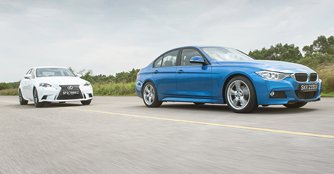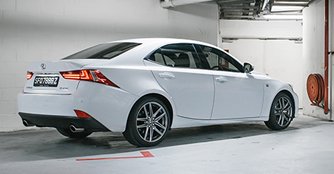BMW 3 Series Sedan 320i Sport (A) vs Lexus IS250 2.5 F Sport (A)
23 Aug 2013|46,916 views
We can imagine how many decisions automakers go through before each new product is launched. They have to think through how sporty or how luxurious the new car should be, or whether it will take on a total revamp or slight makeover in the looks department.
And of course, most of the factors above will be largely construed (or limited) by something known as the 'brand image'. For instance, a Lexus needs to boast a certain level of creature comforts. In penning a new bimmer, designers also have to incorporate the iconic 'twin nostrils'. It is these qualities that give the car its identity.
Lexus of late has also adopted a genetic styling cue - the 'spindle grille', which it proudly wears on its face and shares throughout the entire model range. This is the first generation of IS to undergo such 'family treatment'. As such, the result is revolutionary - nothing quite like what we have seen before.
The new IS aims to be more emotionally appealing. And we have to take our hats off to the Japanese - they hit the right note with the GS, and from initial impressions, this IS is jolly good too. Of course, they didn't come all the way without a mission, and that is to topple the highly regarded 3 Series off the throne.
Exterior
Both cars you see here are spruced-up versions of the 'standard' variants. With help from the BMW M division, the current 3 Series (codenamed F30) wears an M Sport kit to muscle up its already stout appearance - like injecting a catalyst to speed up a tested-and-proven formula.
And of course, most of the factors above will be largely construed (or limited) by something known as the 'brand image'. For instance, a Lexus needs to boast a certain level of creature comforts. In penning a new bimmer, designers also have to incorporate the iconic 'twin nostrils'. It is these qualities that give the car its identity.
Lexus of late has also adopted a genetic styling cue - the 'spindle grille', which it proudly wears on its face and shares throughout the entire model range. This is the first generation of IS to undergo such 'family treatment'. As such, the result is revolutionary - nothing quite like what we have seen before.
The new IS aims to be more emotionally appealing. And we have to take our hats off to the Japanese - they hit the right note with the GS, and from initial impressions, this IS is jolly good too. Of course, they didn't come all the way without a mission, and that is to topple the highly regarded 3 Series off the throne.
Exterior
Both cars you see here are spruced-up versions of the 'standard' variants. With help from the BMW M division, the current 3 Series (codenamed F30) wears an M Sport kit to muscle up its already stout appearance - like injecting a catalyst to speed up a tested-and-proven formula.
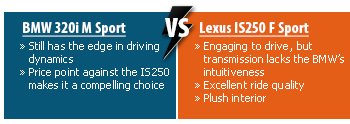 |
We particularly like the bumper extensions, which further strengthen the car's on-road stance, and the entire package is unquestionably appealing.
But when placed next to the IS, the F30's styling feels somewhat predictable.
Make no mistakes - the F30 and IS still carry the conventional proportions of a junior sedan. They also share very similar dimensions. The F30 measures 4,624mm x 1,811mm x 1,429mm (L x W x H) while the IS stands at 4,665mm x 1,810mm x 1,430mm.
Still, the IS does it with more emotions. It packs a lineup of surprises, such as lines and creases at unsuspecting areas. Some are even drawn at highly steep angles to give the car a dynamic look.
This visual drama is further accentuated with the F Sport body kit, which sees it put on a more pronounced front lips and bigger, nicer looking rims.
Based on looks alone, there is no doubt the IS will easily stand out from the crowd.
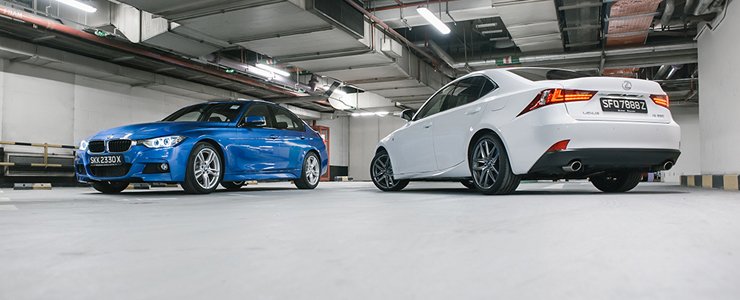 |
Interior
Like their sheet metal, both cabins tell very different tales. The F30's interior is unmistakably Bimmer, carrying the usual hues from the Bavarian marque, such as the driver-centric cockpit and the orange-lit instruments, which boast a simplistic design and are easy on the eye.
BMW's thin-spoke steering (left) is easier to handle, but the Lexus' chunky three-spoke (right) feels more premium
This M Sport variant receives a three-spoke Sport steering wheel. The skinnier spokes give off a different kind of vibe - less clunky and easier to pull through bends.
Even when placed second from the bottom of the range, the 320i gets a decent amount of gadgetry niceties - most useful being the Driving Experience control (selection from a range of driving modes from Eco Pro to Sport), as well as the infotainment system, which is still one of the sweetest to use in the industry.
Like their sheet metal, both cabins tell very different tales. The F30's interior is unmistakably Bimmer, carrying the usual hues from the Bavarian marque, such as the driver-centric cockpit and the orange-lit instruments, which boast a simplistic design and are easy on the eye.
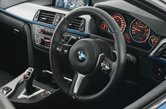 | 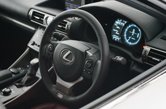 |
This M Sport variant receives a three-spoke Sport steering wheel. The skinnier spokes give off a different kind of vibe - less clunky and easier to pull through bends.
Even when placed second from the bottom of the range, the 320i gets a decent amount of gadgetry niceties - most useful being the Driving Experience control (selection from a range of driving modes from Eco Pro to Sport), as well as the infotainment system, which is still one of the sweetest to use in the industry.
The IS, on the other hand, charms with its intrinsically-styled cabin. For starters, there is the space-age driver's display that was inspired by the marque's halo car - the LFA. It creates a sense of occasion for the driver, especially in either of the Sport modes where the single-dial tachometer glows with a beautiful white background.
The IS does with more creature comforts too. The front seats are ventilated. The cushions and door cards are thicker, and create a more bolstered interior, which elevates the premium feel of the cabin. As a whole, it feels like more effort was spent in putting the cabin together, though it feels slightly more cramped than the F30.
Less curvaceous cushions in the F30 (left) give greater room, while the heavily bolstered bench and raised centre seat hamper space in the IS
The IS does with more creature comforts too. The front seats are ventilated. The cushions and door cards are thicker, and create a more bolstered interior, which elevates the premium feel of the cabin. As a whole, it feels like more effort was spent in putting the cabin together, though it feels slightly more cramped than the F30.
 | 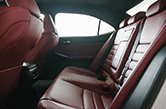 |
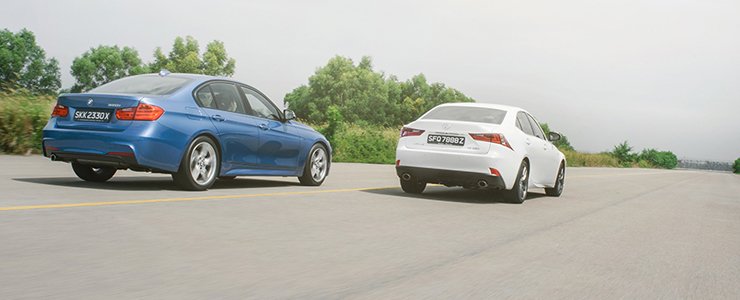 |
The Drive
BMW and Lexus claim that the F30 and IS have their roots laid in providing driving fun. That said, both cars are very different animals altogether, and it is not hard to tell by looking through their spec sheets alone.
The F30 320i packs a force-induced 2.0-litre in-line four engine, and is coupled to an eight-speed Steptronic transmission. On the other hand, the IS250's 2.5-litre V6 strictly relies on atmospheric pressure, and dispatches the drive via a six-speed automatic gearbox.
320i's 2.0-litre (left) churns out 184bhp and 270Nm of torque, while IS250's 2.5-litre (right) deals 205bhp and 252Nm of torque
If straight-line sprint is what you care about the most, then the F30 deserves your vote. Off the line, the 320i's sumptuous low end torque enables it to get up to pace quicker - 7.3 seconds for 0-100km/h compared to 8.1 seconds in the IS.
The bimmer's capable eight-speed Steptronic also helps to translate the engine's potency effectively, and hence the car feels ever-ready to get-up-and-go.
The bimmer's eight-speed Steptronic (left) provides a more delectable and engaging experience than the IS' six-speed automatic (right)
Put the F30 through a series of corners and you will discover the hidden gem beneath this German sedan. The concise and well-weighted steering provides handsome feedbacks, making it fun and engaging to drive.
The IS, on the other hand, has a different set of tricks up its sleeves. Its V6 packs the linearity and creaminess that the bimmer's in-line four lacks. The engine also strikes a good balance, maintaining its poise and posture without being too sedated. To paint a better picture, it will still launch you in a deciding manner should you pedal to the metal, but without putting butterflies in your stomach.
BMW and Lexus claim that the F30 and IS have their roots laid in providing driving fun. That said, both cars are very different animals altogether, and it is not hard to tell by looking through their spec sheets alone.
The F30 320i packs a force-induced 2.0-litre in-line four engine, and is coupled to an eight-speed Steptronic transmission. On the other hand, the IS250's 2.5-litre V6 strictly relies on atmospheric pressure, and dispatches the drive via a six-speed automatic gearbox.
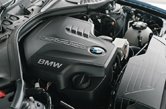 |  |
If straight-line sprint is what you care about the most, then the F30 deserves your vote. Off the line, the 320i's sumptuous low end torque enables it to get up to pace quicker - 7.3 seconds for 0-100km/h compared to 8.1 seconds in the IS.
The bimmer's capable eight-speed Steptronic also helps to translate the engine's potency effectively, and hence the car feels ever-ready to get-up-and-go.
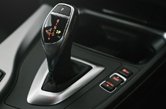 | 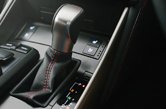 |
Put the F30 through a series of corners and you will discover the hidden gem beneath this German sedan. The concise and well-weighted steering provides handsome feedbacks, making it fun and engaging to drive.
The IS, on the other hand, has a different set of tricks up its sleeves. Its V6 packs the linearity and creaminess that the bimmer's in-line four lacks. The engine also strikes a good balance, maintaining its poise and posture without being too sedated. To paint a better picture, it will still launch you in a deciding manner should you pedal to the metal, but without putting butterflies in your stomach.
And in the midst of doing so, there is a clever device which echoes the V6's soundtrack into the cabin (at your perusal by selecting the Sport mode), which truly enhances the driving experience.
That said, the downside of the IS' drivetrain lies in its six-speeder, which falls behind the bimmer's in terms of intuitiveness and responsiveness.
Despite being fitted with lower profile tyres, the IS' ride is notably more pliant. Even in its hardest Sport S+ setting, riding in the IS is never punishing on pocketed tarmac - and yet it is capable in filtering off body rolls on twisty roads. In comparison, the bimmer feels a tad jittery and nervous over the same type of road surface.
Both cars come with 18-inch shoes, but despite being fitted with lower profile tyres, the IS rides significantly better
Conclusion
Credits where it's due, the F30 still has the edge over the IS when it comes to driving involvement - though that advantage is diminished with this latest incarnation of the IS.
In its entirety, the F30's victories are less substantial compared to the hits of the IS. The latter not only gives you the sporting vibes, but also feels special to pilot.
The biggest downside of the IS, however, lies in its price point. As of 23rd August, the IS250 F Sport retails for $261,000 - a princely $32k premium over the 320i M Sport, which goes for $228,760.
That said, the IS is a more complete car than the F30. And from our point of view, it is definitely a force we would like to be reckoned with.
That said, the downside of the IS' drivetrain lies in its six-speeder, which falls behind the bimmer's in terms of intuitiveness and responsiveness.
Despite being fitted with lower profile tyres, the IS' ride is notably more pliant. Even in its hardest Sport S+ setting, riding in the IS is never punishing on pocketed tarmac - and yet it is capable in filtering off body rolls on twisty roads. In comparison, the bimmer feels a tad jittery and nervous over the same type of road surface.
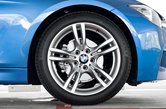 | 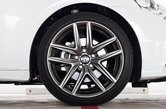 |
Conclusion
Credits where it's due, the F30 still has the edge over the IS when it comes to driving involvement - though that advantage is diminished with this latest incarnation of the IS.
In its entirety, the F30's victories are less substantial compared to the hits of the IS. The latter not only gives you the sporting vibes, but also feels special to pilot.
The biggest downside of the IS, however, lies in its price point. As of 23rd August, the IS250 F Sport retails for $261,000 - a princely $32k premium over the 320i M Sport, which goes for $228,760.
That said, the IS is a more complete car than the F30. And from our point of view, it is definitely a force we would like to be reckoned with.
We can imagine how many decisions automakers go through before each new product is launched. They have to think through how sporty or how luxurious the new car should be, or whether it will take on a total revamp or slight makeover in the looks department.
And of course, most of the factors above will be largely construed (or limited) by something known as the 'brand image'. For instance, a Lexus needs to boast a certain level of creature comforts. In penning a new bimmer, designers also have to incorporate the iconic 'twin nostrils'. It is these qualities that give the car its identity.
Lexus of late has also adopted a genetic styling cue - the 'spindle grille', which it proudly wears on its face and shares throughout the entire model range. This is the first generation of IS to undergo such 'family treatment'. As such, the result is revolutionary - nothing quite like what we have seen before.
The new IS aims to be more emotionally appealing. And we have to take our hats off to the Japanese - they hit the right note with the GS, and from initial impressions, this IS is jolly good too. Of course, they didn't come all the way without a mission, and that is to topple the highly regarded 3 Series off the throne.
Exterior
Both cars you see here are spruced-up versions of the 'standard' variants. With help from the BMW M division, the current 3 Series (codenamed F30) wears an M Sport kit to muscle up its already stout appearance - like injecting a catalyst to speed up a tested-and-proven formula.
And of course, most of the factors above will be largely construed (or limited) by something known as the 'brand image'. For instance, a Lexus needs to boast a certain level of creature comforts. In penning a new bimmer, designers also have to incorporate the iconic 'twin nostrils'. It is these qualities that give the car its identity.
Lexus of late has also adopted a genetic styling cue - the 'spindle grille', which it proudly wears on its face and shares throughout the entire model range. This is the first generation of IS to undergo such 'family treatment'. As such, the result is revolutionary - nothing quite like what we have seen before.
The new IS aims to be more emotionally appealing. And we have to take our hats off to the Japanese - they hit the right note with the GS, and from initial impressions, this IS is jolly good too. Of course, they didn't come all the way without a mission, and that is to topple the highly regarded 3 Series off the throne.
Exterior
Both cars you see here are spruced-up versions of the 'standard' variants. With help from the BMW M division, the current 3 Series (codenamed F30) wears an M Sport kit to muscle up its already stout appearance - like injecting a catalyst to speed up a tested-and-proven formula.
We particularly like the bumper extensions, which further strengthen the car's on-road stance, and the entire package is unquestionably appealing.
But when placed next to the IS, the F30's styling feels somewhat predictable.
Make no mistakes - the F30 and IS still carry the conventional proportions of a junior sedan. They also share very similar dimensions. The F30 measures 4,624mm x 1,811mm x 1,429mm (L x W x H) while the IS stands at 4,665mm x 1,810mm x 1,430mm.
Still, the IS does it with more emotions. It packs a lineup of surprises, such as lines and creases at unsuspecting areas. Some are even drawn at highly steep angles to give the car a dynamic look.
This visual drama is further accentuated with the F Sport body kit, which sees it put on a more pronounced front lips and bigger, nicer looking rims.
Based on looks alone, there is no doubt the IS will easily stand out from the crowd.
But when placed next to the IS, the F30's styling feels somewhat predictable.
Make no mistakes - the F30 and IS still carry the conventional proportions of a junior sedan. They also share very similar dimensions. The F30 measures 4,624mm x 1,811mm x 1,429mm (L x W x H) while the IS stands at 4,665mm x 1,810mm x 1,430mm.
Still, the IS does it with more emotions. It packs a lineup of surprises, such as lines and creases at unsuspecting areas. Some are even drawn at highly steep angles to give the car a dynamic look.
This visual drama is further accentuated with the F Sport body kit, which sees it put on a more pronounced front lips and bigger, nicer looking rims.
Based on looks alone, there is no doubt the IS will easily stand out from the crowd.
Interior
Like their sheet metal, both cabins tell very different tales. The F30's interior is unmistakably Bimmer, carrying the usual hues from the Bavarian marque, such as the driver-centric cockpit and the orange-lit instruments, which boast a simplistic design and are easy on the eye.
This M Sport variant receives a three-spoke Sport steering wheel. The skinnier spokes give off a different kind of vibe - less clunky and easier to pull through bends.
Even when placed second from the bottom of the range, the 320i gets a decent amount of gadgetry niceties - most useful being the Driving Experience control (selection from a range of driving modes from Eco Pro to Sport), as well as the infotainment system, which is still one of the sweetest to use in the industry.
The IS, on the other hand, charms with its intrinsically-styled cabin. For starters, there is the space-age driver's display that was inspired by the marque's halo car - the LFA. It creates a sense of occasion for the driver, especially in either of the Sport modes where the single-dial tachometer glows with a beautiful white background.
The IS does with more creature comforts too. The front seats are ventilated. The cushions and door cards are thicker, and create a more bolstered interior, which elevates the premium feel of the cabin. As a whole, it feels like more effort was spent in putting the cabin together, though it feels slightly more cramped than the F30.
The IS does with more creature comforts too. The front seats are ventilated. The cushions and door cards are thicker, and create a more bolstered interior, which elevates the premium feel of the cabin. As a whole, it feels like more effort was spent in putting the cabin together, though it feels slightly more cramped than the F30.
The Drive
BMW and Lexus claim that the F30 and IS have their roots laid in providing driving fun. That said, both cars are very different animals altogether, and it is not hard to tell by looking through their spec sheets alone.
The F30 320i packs a force-induced 2.0-litre in-line four engine, and is coupled to an eight-speed Steptronic transmission. On the other hand, the IS250's 2.5-litre V6 strictly relies on atmospheric pressure, and dispatches the drive via a six-speed automatic gearbox.
If straight-line sprint is what you care about the most, then the F30 deserves your vote. Off the line, the 320i's sumptuous low end torque enables it to get up to pace quicker - 7.3 seconds for 0-100km/h compared to 8.1 seconds in the IS.
The bimmer's capable eight-speed Steptronic also helps to translate the engine's potency effectively, and hence the car feels ever-ready to get-up-and-go.
Put the F30 through a series of corners and you will discover the hidden gem beneath this German sedan. The concise and well-weighted steering provides handsome feedbacks, making it fun and engaging to drive.
The IS, on the other hand, has a different set of tricks up its sleeves. Its V6 packs the linearity and creaminess that the bimmer's in-line four lacks. The engine also strikes a good balance, maintaining its poise and posture without being too sedated. To paint a better picture, it will still launch you in a deciding manner should you pedal to the metal, but without putting butterflies in your stomach.
BMW and Lexus claim that the F30 and IS have their roots laid in providing driving fun. That said, both cars are very different animals altogether, and it is not hard to tell by looking through their spec sheets alone.
The F30 320i packs a force-induced 2.0-litre in-line four engine, and is coupled to an eight-speed Steptronic transmission. On the other hand, the IS250's 2.5-litre V6 strictly relies on atmospheric pressure, and dispatches the drive via a six-speed automatic gearbox.
If straight-line sprint is what you care about the most, then the F30 deserves your vote. Off the line, the 320i's sumptuous low end torque enables it to get up to pace quicker - 7.3 seconds for 0-100km/h compared to 8.1 seconds in the IS.
The bimmer's capable eight-speed Steptronic also helps to translate the engine's potency effectively, and hence the car feels ever-ready to get-up-and-go.
Put the F30 through a series of corners and you will discover the hidden gem beneath this German sedan. The concise and well-weighted steering provides handsome feedbacks, making it fun and engaging to drive.
The IS, on the other hand, has a different set of tricks up its sleeves. Its V6 packs the linearity and creaminess that the bimmer's in-line four lacks. The engine also strikes a good balance, maintaining its poise and posture without being too sedated. To paint a better picture, it will still launch you in a deciding manner should you pedal to the metal, but without putting butterflies in your stomach.
And in the midst of doing so, there is a clever device which echoes the V6's soundtrack into the cabin (at your perusal by selecting the Sport mode), which truly enhances the driving experience.
That said, the downside of the IS' drivetrain lies in its six-speeder, which falls behind the bimmer's in terms of intuitiveness and responsiveness.
Despite being fitted with lower profile tyres, the IS' ride is notably more pliant. Even in its hardest Sport S+ setting, riding in the IS is never punishing on pocketed tarmac - and yet it is capable in filtering off body rolls on twisty roads. In comparison, the bimmer feels a tad jittery and nervous over the same type of road surface.
Conclusion
Credits where it's due, the F30 still has the edge over the IS when it comes to driving involvement - though that advantage is diminished with this latest incarnation of the IS.
In its entirety, the F30's victories are less substantial compared to the hits of the IS. The latter not only gives you the sporting vibes, but also feels special to pilot.
The biggest downside of the IS, however, lies in its price point. As of 23rd August, the IS250 F Sport retails for $261,000 - a princely $32k premium over the 320i M Sport, which goes for $228,760.
That said, the IS is a more complete car than the F30. And from our point of view, it is definitely a force we would like to be reckoned with.
That said, the downside of the IS' drivetrain lies in its six-speeder, which falls behind the bimmer's in terms of intuitiveness and responsiveness.
Despite being fitted with lower profile tyres, the IS' ride is notably more pliant. Even in its hardest Sport S+ setting, riding in the IS is never punishing on pocketed tarmac - and yet it is capable in filtering off body rolls on twisty roads. In comparison, the bimmer feels a tad jittery and nervous over the same type of road surface.
Conclusion
Credits where it's due, the F30 still has the edge over the IS when it comes to driving involvement - though that advantage is diminished with this latest incarnation of the IS.
In its entirety, the F30's victories are less substantial compared to the hits of the IS. The latter not only gives you the sporting vibes, but also feels special to pilot.
The biggest downside of the IS, however, lies in its price point. As of 23rd August, the IS250 F Sport retails for $261,000 - a princely $32k premium over the 320i M Sport, which goes for $228,760.
That said, the IS is a more complete car than the F30. And from our point of view, it is definitely a force we would like to be reckoned with.
Car Information
BMW 3 Series Sedan 320i Sport (A)
CAT B|Petrol|16.6km/L
Horsepower
137kW (184 bhp)
Torque
270 Nm
Acceleration
7.6sec (0-100km /hr)
This model is no longer being sold by local distributor
All Used BMW 3 Series SedanLexus IS250 2.5 F Sport (A)
CAT B|Petrol|10.8km/L
Horsepower
155kW (208 bhp)
Torque
252 Nm
Acceleration
8.1sec (0-100km /hr)
This model is no longer being sold by local distributor
All Used Lexus IS250Thank You For Your Subscription.














































